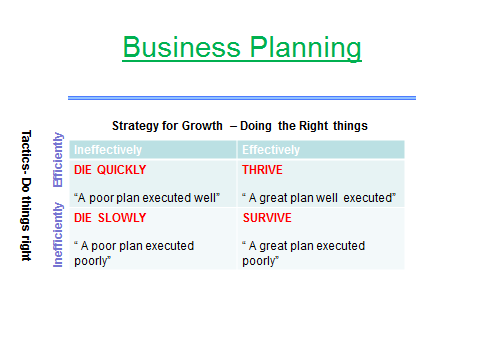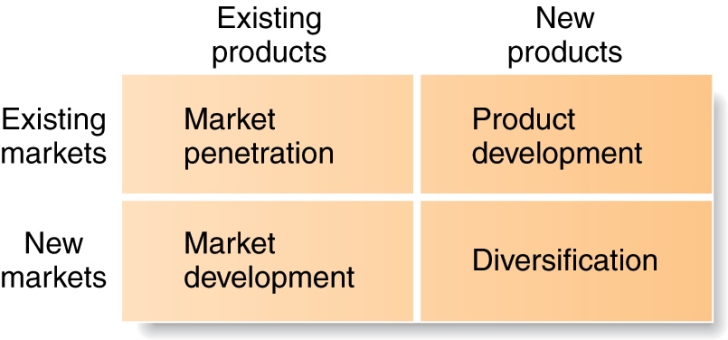Devising a Business Plan and Strategy for Growth
Business plan and implementing a business strategy is more than simply achieving business goals. It inspires people to work hard, makes the team feel part of a purpose; it incites actions and ensures that activities happen. Simply constructed, effectively executed, a business strategy is a template for business success.
- Take Time to Think
A business needs strategic thinking before any strategic planning. Maybe the biggest strategic obstacle to any business is if they can out think their competitors.
“If today was the last day of your life, would you do what you are about to do today” Steve Jobs
- Ask and Answer Key Business Questions
- The purpose of the business
- Strength of the team
- Current effectiveness
- Financial resources of the company
- Target market trends
- Current market position
- Know the Business Why
- Real planning and growth strategies are founded on “Business Purpose”
- Vision: where the business is going in the long-term
- Mission: the business purpose and reason WHY for existing
- Values: Who and what the business stands for
- Business Mission
- Think about the Business Mission
- The business mission concentrates on the here and now. A mission statement defines the fundamental purpose of any business. It identifies who the company is, what it does, and who it serves.
- Why do Business Planning?
A business plan gives a business options, it can Die Quickly, Die slowly, survive or thrive. Doing nothing is not an option; a no business plan is the weakest plan of all.
- A business strategy to Thrive
- Start with goals – what do I want out of this business?
- Create a vision of what the business needs to look like in order to accomplish your goals.
- Create a business mission to guide you along the way.
- Develop strategies to get you from where you are now to where you want to be in the future. Strategies require investments – which mean budgets, resources and timelines.
- What is strategic business planning?
Strategic planning is the process of determining the primary business purpose (the “WHY”), putting in place goals and tactics, then adopting courses of action and allocating resources to achieve the selected goals and tactics.
What causes business success?
- Has history shown us that the No.1 business killer is lack of market?
- When a great business team meets a stagnant market, market wins. When an average business team meets a great market, market wins. But when a great business team meets a great market, then something really special happens.
- Ideal Growth Plan
- Desirable products or Services
- Big enough market
- An economical way to target and serve it.
- Note: Product quality will not create market size; Steve Jobs learned that lesson with his NeXT business.
- Market Penetration – selling more of the same things to more of the same customers
- Market Development – selling more of the same things to different customers
- Product Development – selling new products or services to the same customers
- Diversification – selling new products or services to different customers
Market penetration
Market penetration is the name given to a growth strategy where the business focuses on selling existing products into existing markets.
Market penetration seeks to achieve four main objectives:
- Maintain or increase the market share of current products – this can be achieved by a combination of competitive pricing strategies, advertising, sales promotion and perhaps more resources dedicated to personal selling
- Secure dominance of growth markets
- Restructure a mature market by driving out competitors; this would require a much more aggressive promotional campaign, supported by a pricing strategy designed to make the market unattractive for competitors
- Increase usage by existing customers – for example by introducing loyalty schemes
A market penetration marketing strategy is very much about “business as usual”. The business is focusing on markets and products it knows well. It is likely to have good information on competitors and on customer needs. It is unlikely, therefore, that this strategy will require much investment in new market research.
Market development
Market development is the name given to a growth strategy where the business seeks to sell its existing products into new markets.
There are many possible ways of approaching this strategy, including:
- New geographical markets; for example exporting the product to a new country
- New product dimensions or packaging: for example
- New distribution channels (e.g. moving from selling via retail to selling using e-commerce and mail order)
- Different pricing policies to attract different customers or create new market segments
Market development is a more risky strategy than market penetration because of the targeting of new markets.
Product development
Product development is the name given to a growth strategy where a business aims to introduce new products into existing markets. This strategy may require the development of new competencies and requires the business to develop modified products which can appeal to existing markets.
A strategy of product development is particularly suitable for a business where the product needs to be differentiated in order to remain competitive. A successful product development strategy places the marketing emphasis on:
- Research & development and innovation
- Detailed insights into customer needs (and how they change)
- Being first to market
Diversification
Diversification is the name given to the growth strategy where a business markets new products in new markets.
This is an inherently more risk strategy because the business is moving into markets in which it has little or no experience.
For a business to adopt a diversification strategy, therefore, it must have a clear idea about what it expects to gain from the strategy and an honest assessment of the risks. However, for the right balance between risk and reward, a marketing strategy of diversification can be highly rewarding.
- All Business Plans need Resources
Money – to fund cash flow, product, materials and resources
Information – Market and product research, market trends, market size, customer profiling, customer acquisition
People – The team needed to facilitate the growth plan, to execute the plan, to manage the costs
The success of a business strategy depends on the resources available to thee business. A good tip is to follow this 5 Step Planning Process
- Imagine – what products or services
- Dissect – data and customer feedback
- Expand – market research and tasks
- Analyse – results, information, investment
- Sell – customer acquisition, marketing, sales
Every business should develop a “strategic hypothesis” and test it out making very small bets. Try to sell the idea to a customer before it’s built, look for a supplier, and ask a mentor or advisor who has some expertise in the new area.
10. People don’t plan to fail, they just fail to plan
A business plan for growth should be grounded in your Business Purpose, Mission and Core Values, a solid business strategy will help you develop a plan of action and maximise your likelihood of success in achieving your vision.


One thought on “Business Plan for Growth”
Comments are closed.